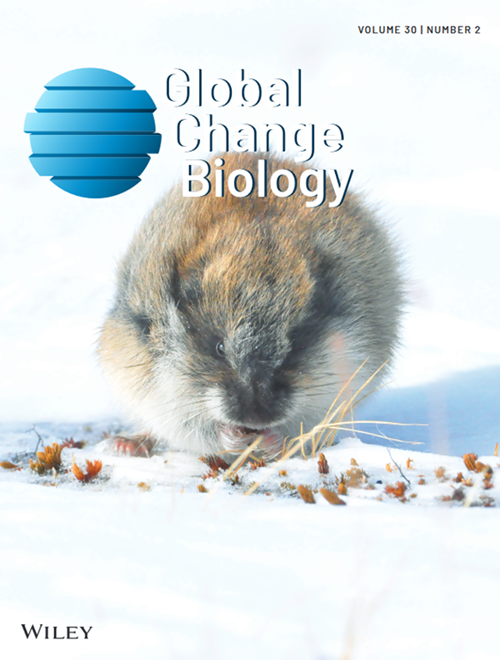
Kantola et al. (2023) (K23) report data on carbon dioxide removal (CDR) via enhanced weathering (EW) after applying ground basalt to agricultural plots. Here, we argue that their methodology does not allow them to assess whether EW fluxes are significantly different from zero at the 1 standard error level (≈83% CI).
To summarize: K23 applied 5 kg m−2 year−1 Blue Ridge meta-basalt for 4 years for a total nominal input of 20 kg m−2. To trace the fate of these additions and extrapolate CO2 consumption rates, they analyzed rare earth elements (REE) in the amended and control soils before and after the application, and reported the average for five plots for each of the four cases. Based on these data, they concluded enhanced weathering (EW) consumed between 102 (maize/soy) and 234 gC m−2 year−1 (Miscanthus).
A difficulty with these types of experiments is that they add a small amount of material to a much larger and variable pool, so the signal-to-noise ratio is inherently low. Consequently, subtle geochemical nuances can undermine the experimenters' ability to draw robust conclusions. In the case of K23, we find this problem arises from (a) analysis of the geochemical data without appropriately treating the uncertainty of the dependent and independent variables and (b) reliance on chemical analyses of the added basalt that are well below accepted quality for whole-rock analyses. We elaborate on each below.
As soils are sampled at a small spatial scale, field-based average rates of basalt addition cannot predict what a particular soil sample received. K23 uses REE concentrations in the added basalt and recipient soils to estimate what was added to each specific soil. Because the individual REE concentrations in the pre- and post-treatment soils were not significantly different, K23 plotted (REEpost—REEpre) as a function of REEbasalt. From this, they obtained an OLS (ordinary least squares) slope = 0.0409 ± 0.0027 after forcing the fit through the origin.
However, the REE data have uncertainties in both the independent (x) and dependent (y) variables, and these uncertainties are likely correlated with the variables—thus OLS is not an appropriate analysis. Instead, the appropriate regression method is a maximum likelihood estimator (MLE; York et al. 2004). We estimated the uncertainties in the data using the sampling variance and assuming a moderate 4% analytical uncertainty (since none were given) and calculated the error correlation r (s.e.basalt, s.e.∆soil). The resulting estimate of slope is lower, and the uncertainty is larger by a factor of ≈5 (Figure 1), which directly propagates to the estimate of how much basalt was added to a given soil sample over the 4-year experiment.
For both, we propagated all uncertainties using Monte Carlo simulation with 10,000 realizations of each variable, assuming a mean and standard deviation obtained from the reported sampling variance and an assumed analytical uncertainty of 4%. Table 1 compares the results from the two approaches with those given by K23. Importantly, regardless of the approach, making the corrections above results in much lower CDR and much larger uncertainties with CV > 100%. None of the methods yield a CDR result that is distinguishable from zero at the 1 s.e. level.
The discussion above is of the method K23 uses for additions to the maize/soy system. K23 uses a different slope method for a similar experiment with a Micanthus crop—comparing the HREE in the basalt with HREE in the pre- and post-treatment soils. Again, they use an OLS fit and find slightly different slopes but give no uncertainties. The data have uncertainties in both axes, and so an appropriate regression technique is reduced major axis regression (RMA) (Sokal and Rohlf 1995). Including the uncertainties in both variables, the pre- and post-slopes are 0.930 ± 0.110 and 0.963 ± 0.077 (1 s.e.) and are not distinguishable. Thus, given more appropriate statistical treatment, the purported differences in the micanthus pre- and post-treatment HREE slopes provide no constraint on basalt addition or CDR that is different from zero.
In addition to the error propagation issue described above, we suspect there are data quality issues with the chemical analyses of the added basalt. K23 reports elemental data on soils but does not report any analytical uncertainties or data from any certified reference materials for either soil or basalt, making it impossible to fully assess data quality, and this ignores widely accepted practice in geochemistry. We followed K23 citations to the major element data for the basalt found in Lewis et al. (2021). The Blue Ridge basalt data, when converted to oxide wt%, sum to 78%. This is far from normally accepted standards for whole-rock analyses (100% ± 2%) and indicates poor data quality, implying yet larger uncertainties that are impossible to assess fully but certainly further undermine the claim that there was resolvable and substantial basalt weathering and CO2 consumption in this experiment.
Because of conceptual, data, and execution errors, K23 arrives at a substantial overestimate of CDR for their field experiments and a substantial underestimate of the uncertainties. Reanalyzing their data with appropriate regression methods, an estimate of analytical uncertainties, and appropriate mass balance and error propagation methods, we find that for both the maize and Miscanthus plots, H0 is not invalidated, that is, that CDR is within uncertainty (1 s.e.) of zero in both cases. The data and analyses in K23 do not provide any statistically valid constraint in CDR from basalt addition to agricultural fields. This study and our re-analysis highlight some of the difficulties in resolving small changes in soil chemistry associated with crushed rock amendments and subsequent weathering in inherently spatially variable and noisy soil systems.
L. A. Derry: conceptualization, formal analysis, writing – original draft. O. A. Chadwick: writing – review and editing. S. Porder: writing – review and editing.
The authors declare no conflicts of interest.
This article is a Letter to the Editor regarding Kantola et al, https://doi.org/10.1111/gcb.16903.


